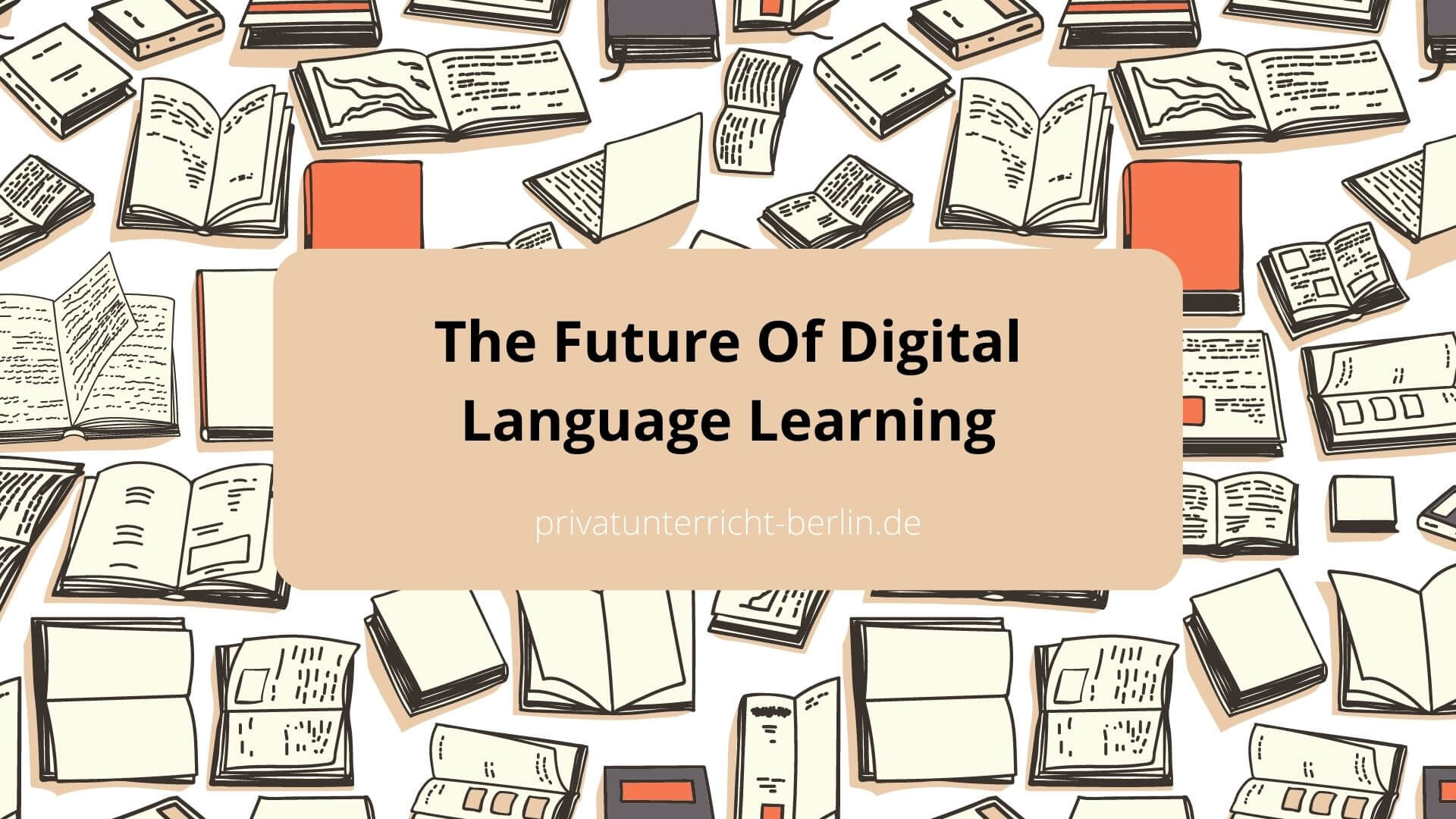Your Language Journey, Your Way: Start with a Private Tutor

The Future Of Digital Language Learning
Hey there, language learners! As a digital language learning expert, I’m excited to share the future of language learning in the digital space.
With technology advancing at an unprecedented rate, it’s no surprise that we see significant changes and improvements in language learning platforms.
In the past few years, we’ve seen an increase in personalized and adaptive learning experiences for users. As you progress through your language journey, the content and activities presented are tailored to your ability level and interests.
Additionally, artificial intelligence (AI) is more prominent in language learning tools, offering features such as real-time translation and voice recognition software. These advancements have made it easier to learn languages on the go and connect with native speakers worldwide.
So let’s dive into what this all means for the future of digital language learning!
Table of Contents
Personalized Learning Experiences
Imagine a world where language learning is not just about memorizing vocabulary and grammar rules but an adventure that takes you on a journey through different cultures and experiences.
Thanks to advanced gamification techniques and virtual reality immersion, personalized learning experiences are now more accessible than ever.
Digital language learning experts have long recognized the potential of gamification techniques in engaging learners and enhancing their retention rates.
By incorporating elements such as points, badges, leaderboards, and rewards into language lessons, learners feel motivated to continue practicing until they achieve mastery.
Virtual reality immersion takes this one step further by providing learners with a simulated environment where they can practice real-life scenarios without leaving the comfort of their homes.
As a result, learners gain confidence in using the language in practical situations while having fun at the same time.
Adaptive Learning Technology
When it comes to adaptive learning technology, personalized learning experiences, and Artificial Intelligence-driven content are the way of the future.
With this technology, learners can get a tailored experience that caters to their individual needs, while AI algorithms provide constantly adapting and improving content.
Personalized Learning Experiences
As digital language learning continues to evolve, personalized learning experiences are becoming increasingly popular. This means learners can tailor their courses based on specific goals and interests, using gamification techniques to keep them engaged and motivated.
By incorporating game design elements into the learning experience, such as point systems, rewards for achievements, and leaderboards, learners are encouraged to continue studying and practicing to improve their scores.
Additionally, with the help of learning analytics technology, teachers can monitor each student’s progress closely and provide feedback accordingly. This allows students to identify areas where they need more work or assistance and adjust their coursework accordingly.
With these tools, we can create genuinely individualized learning experiences that cater to each learner’s strengths and weaknesses.
Artificial Intelligence-Driven Content
Now, let’s move on to another exciting subtopic in adaptive learning technology – Artificial Intelligence-Driven Content.
With the help of AI-powered interactive chatbots, language learners can now engage in real-time conversations with virtual language partners that simulate natural communication. This innovative approach improves speaking and listening skills and provides instant feedback on grammar and pronunciation errors.
Furthermore, AI-powered gamified language learning experiences allow for personalized content recommendations based on individual progress and interests. By utilizing data-driven insights, educators can create tailor-made courses that cater to each learner’s unique needs and preferences.
As digital language learning continues to evolve rapidly, we can expect even more sophisticated AI-driven solutions to enhance our language acquisition journeys.
Artificial Intelligence In Language Learning
Adaptive learning technology has revolutionized digital language learning by personalizing the experience for each learner. However, another exciting development promises to take language education to an even higher level: Artificial Intelligence (AI).
AI technology allows learners to interact with intelligent algorithms and improve their skills through natural conversations. Artificial Intelligence in Language Learning offers a wide range of opportunities that can enhance how people learn languages.
Here are some ways that AI is making headway into language learning:
- Interactive chatbots provide instant feedback on pronunciation, grammar, vocabulary, and more.
- Virtual reality immersion creates immersive environments where learners experience real-world situations related to language use.
- Adaptive assessments continuously monitor progress and adjust course material according to the individual’s pace and needs.
- Gamification techniques create fun and engaging activities encouraging learners to practice their language skills.
- Personalized curriculums cater to individual interests and goals.
With advancements in AI technology, we are seeing considerable improvements in how quickly people learn new languages. As we continue exploring the potential of artificial intelligence, we will see many more innovative developments emerging from this field.
One such area worth mentioning is real-time translation – which allows individuals speaking different languages to communicate seamlessly without any barriers.
Real-Time Translation
Accurate translation is the primary concern regarding real-time translation, and automated solutions can help make this process more efficient.
It’s important to remember, though, that no matter how advanced the technology is, it still can’t replicate the nuance of a native speaker.
Accurate Translation
As digital language learning continues to evolve, accurate translation is becoming a crucial aspect of real-time translation. With the rise in crowdsourced translations and machine learning algorithms, learners must have access to reliable translations that accurately convey the intended meaning.
One of the biggest challenges in achieving this accuracy is understanding context, which can often be lost or misunderstood when translating word for word. This is where machine learning algorithms come into play – they can analyze patterns and understand the context of vast amounts of data.
Combining these algorithms with crowdsourced translations allows us to create a more comprehensive database of the translated text, allowing learners to receive quick and accurate translations in real-time. But as technology advances, it will also be essential to continue refining these methods to ensure an even higher level of accuracy.
Automated Solutions
Now that we’ve explored the importance of accurate translation and how machine learning algorithms can help achieve it let’s dive into another aspect of real-time translation: automated solutions.
As digital language learning continues to advance, more and more technologies are being developed to assist learners in their language journey. Gamification is one such technology – by adding game design elements to language learning apps, users are encouraged to engage with the material and stay motivated throughout the process. Virtual reality is also becoming increasingly popular as a tool for immersive language learning experiences.
But where do automated solutions come in? Automated solutions can range from chatbots that provide instant translations to speech recognition software that transcribes conversations in real time. These solutions save time and allow learners to practice their speaking and listening skills without fear of embarrassment or judgment.
As technology continues to evolve, so will the capabilities of these automated solutions, making real-time translation an even more seamless part of our daily lives.
Connecting With Native Speakers
As we continue to explore the future of digital language learning, one cannot overlook the importance of connecting with native speakers. This is crucial for anyone who wants to learn a new language and gain fluency quickly. Online language exchange platforms offer an excellent way to do this. By pairing learners with native speakers in real-time video chats, online language exchanges create opportunities for cultural immersion that textbooks or apps alone can’t provide.
Through these exchanges, you’ll have someone to practice your conversational skills with and get insights into the culture and customs of the countries where your target language is spoken. Moreover, it’s possible to find people from different backgrounds who may be interested in similar hobbies as yours. For example, if you love cooking or sports, you could connect with a native speaker with identical interests while practicing your conversation skills simultaneously.
To help illustrate some great options for online language exchange platforms out there today, here are three popular ones:
| Online Language Exchange Platform | Description | Best Feature | Price Range (per hour) |
|---|---|---|---|
| iTalki | One-on-one lessons with certified teachers or community tutors. | Large selection of professional teachers. | $5-$80 |
| Tandem | Pairing users with like-minded learners and natives based on shared interests. | User-friendly app interface. | Free – $30 |
| Verbling | One-on-one lessons with vetted instructors; group classes available too. | Quick booking system & class recordings available after each lesson. | $18-$50 |
With so many choices available, finding a platform that best suits your needs and goals should be relatively easy. So why not take advantage of what technology offers us? Connecting with native speakers through online language exchanges will allow you to improve your linguistic abilities and experience various first-hand cultures worldwide.
Frequently Asked Questions
How Will Digital Language Learning Impact Traditional Classroom-Based Language Learning?
As an expert in digital language learning, integrating AI and gamification will revolutionize traditional classroom-based language learning.
With AI-powered platforms, learners can receive personalized feedback and access a vast collection of resources and real-time analysis of their progress.
Gamification techniques such as leaderboards or reward systems make language learning more engaging and motivating for students.
However, traditional classroom-based language learning will still be replaced entirely.
Instead, these new technologies should complement existing methods to enhance the learning experience.
By combining the advantages of both digital and physical classrooms, we can create a more holistic approach to language education that caters to different learning styles and needs.
What Are The Potential Privacy Concerns Associated With Using Digital Language Learning Platforms?
As a digital language learning expert, it’s essential to investigate the truth of a theory. When it comes to using digital platforms for language learning, there are potential privacy concerns that need to be addressed.
Data protection and user tracking are two keywords that come to mind when discussing these concerns. Users’ personal information must be kept secure while they learn online.
As an educator or learner, you want to focus on your studies without worrying about who has access to your data. By addressing these issues upfront, we can ensure that digital language learning remains safe and accessible for all learners.
Will Digital Language Learning Eventually Replace The Need For Human Language Teachers?
Will digital language learning eventually replace the need for human language teachers?
This question has been on the minds of many in the industry. While AI language tutors have grown increasingly popular, there still needs to be more debate over their effectiveness compared to human interaction.
As a digital language learning expert, I believe it’s important to acknowledge both modes of instruction’s potential benefits and limitations. Digital platforms can provide personalized and flexible learning experiences, but they may lack the empathy and cultural nuances that come with interacting face-to-face with another person.
Ultimately, I don’t think we will see one completely replacing the other. Instead, they will continue evolving as complementary tools for language learners seeking different educational experiences.
How Does The Cost Of Digital Language Learning Compare To Traditional Language Learning Methods?
When comparing the cost of digital language learning to traditional methods, it’s important to consider online accessibility and personalized learning.
Online language courses often offer more affordable options than in-person classes because they don’t require physical resources or classroom space.
Additionally, personalized learning allows students to progress at their own pace, saving time and money by eliminating the need for additional lessons or tutoring sessions.
As a digital language learning expert, I believe these factors make online courses attractive for those seeking cost-effective and efficient language education solutions.
What Are The Potential Cultural Implications Of Relying On Technology For Language Learning?
It’s ironic how we’re discussing the potential cultural implications of relying on technology for language learning when the very invention of writing had similar concerns. Back then, people worried that written words would replace oral tradition and ruin communication. But here we are today, able to communicate with each other through various mediums thanks to the evolution of languages.
Similarly, digital language learning has its own set of challenges – both positive and negative – on the impact on communication and effect on language retention. While it allows learners to access diverse resources at their fingertips, it can also create a disconnect from real-life interaction and hinder the natural acquisition of linguistic nuances.
As a digital language learning expert, finding balance is critical: using technology as an aid rather than a replacement for traditional methods can help us reap its benefits while avoiding any adverse effects.
Conclusion
In conclusion, the future of digital language learning is bright and promising. With advancements in technology, students can learn at their own pace and in a personalized way that caters to their individual needs.
However, it is vital to consider the potential privacy concerns associated with using these platforms.
While digital language learning has benefits, it may mean something other than human language teachers will become obsolete. The role of a teacher goes beyond just teaching grammar and vocabulary; they provide cultural context and foster interpersonal communication skills. Therefore, traditional classroom-based and digital language learning has a place in education.
As a digital language learning expert, integrating technology into language education can enhance the student experience while valuing the importance of human interaction. Albert Einstein once said, ‘I never teach my pupils; I only attempt to provide the conditions in which they can learn.’ Technology allows those conditions to be met more effectively than ever before.



